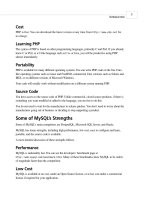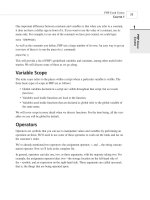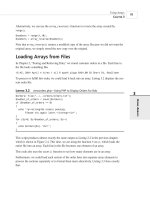Unity in Action Phát triển game với Unity
Bạn đang xem bản rút gọn của tài liệu. Xem và tải ngay bản đầy đủ của tài liệu tại đây (16.72 MB, 352 trang )
Multiplatform game development in C#
Covers Unity 5
Joseph Hocking
FOREWORD BY Jesse Schell
MANNING
www.it-ebooks.info
Unity in Action
www.it-ebooks.info
ii
www.it-ebooks.info
Unity in Action
Multiplatform Game Development in C#
JOSEPH HOCKING
MANNING
SHELTER ISLAND
www.it-ebooks.info
iv
For online information and ordering of this and other Manning books, please visit
www.manning.com. The publisher offers discounts on this book when ordered in quantity.
For more information, please contact
Special Sales Department
Manning Publications Co.
20 Baldwin Road
PO Box 761
Shelter Island, NY 11964
Email:
©2015 by Manning Publications Co. All rights reserved.
No part of this publication may be reproduced, stored in a retrieval system, or transmitted, in
any form or by means electronic, mechanical, photocopying, or otherwise, without prior written
permission of the publisher.
Many of the designations used by manufacturers and sellers to distinguish their products are
claimed as trademarks. Where those designations appear in the book, and Manning
Publications was aware of a trademark claim, the designations have been printed in initial caps
or all caps.
Recognizing the importance of preserving what has been written, it is Manning’s policy to have
the books we publish printed on acid-free paper, and we exert our best efforts to that end.
Recognizing also our responsibility to conserve the resources of our planet, Manning books are
printed on paper that is at least 15 percent recycled and processed without elemental chlorine.
Manning Publications Co.
20 Baldwin Road
PO Box 761
Shelter Island, NY 11964
Development editor:
Technical development editor:
Copyeditor:
Proofreader:
Technical proofreader:
Typesetter:
Cover designer:
ISBN: 9781617292323
Printed in the United States of America
1 2 3 4 5 6 7 8 9 10 – EBM – 20 19 18 17 16 15
www.it-ebooks.info
Dan Maharry
Scott Chaussee
Elizabeth Welch
Melody Dolab
Christopher Haupt
Marija Tudor
Marija Tudor
brief contents
PART 1
PART 2
PART 3
FIRST STEPS ................................................................ 1
1
■
2
■
3
■
4
■
Getting to know Unity 3
Building a demo that puts you in 3D space 21
Adding enemies and projectiles to the 3D game
Developing graphics for your game 69
46
GETTING COMFORTABLE ........................................... 93
5
■
6
■
7
■
8
■
Building a Memory game using Unity’s new 2D
functionality 95
Putting a 2D GUI in a 3D game 119
Creating a third-person 3D game: player movement
and animation 140
Adding interactive devices and items within the game
167
STRONG FINISH . ...................................................... 193
9
■
10
■
11
■
12
■
Connecting your game to the internet 195
Playing audio: sound effects and music 222
Putting the parts together into a complete game
Deploying your game to players’ devices 276
v
www.it-ebooks.info
246
vi
BRIEF CONTENTS
www.it-ebooks.info
contents
foreword xv
preface xvii
acknowledgments xix
about this book xx
PART 1
1
FIRST STEPS . ................................................... 1
Getting to know Unity 3
1.1
Why is Unity so great?
4
Unity's strengths and advantages 4 Downsides to be
aware of 6 Example games built with Unity 7
■
■
1.2
How to use Unity
9
Scene view, Game view, and the Toolbar 10 Using the mouse
and keyboard 11 The Hierarchy tab and the Inspector 12
The Project and Console tabs 13
■
■
1.3
Getting up and running with Unity programming
How code runs in Unity: script components 15 Using
MonoDevelop, the cross-platform IDE 16 Printing to the
console: Hello World! 17
■
■
1.4
Summary
20
vii
www.it-ebooks.info
14
viii
CONTENTS
2
Building a demo that puts you in 3D space 21
2.1
Before you start…
22
Planning the project
2.2
22
■
Understanding 3D coordinate space
Begin the project: place objects in the scene
23
25
The scenery: floor, outer walls, inner walls 25 Lights and
cameras 27 The player’s collider and viewpoint 29
■
■
2.3
Making things move: a script that applies transforms 30
Diagramming how movement is programmed 30 Writing code to
implement the diagram 31 Local vs. global coordinate space 32
■
■
2.4
Script component for looking around: MouseLook
33
Horizontal rotation that tracks mouse movement 35 Vertical
rotation with limits 35 Horizontal and vertical rotation at the
same time 38
■
■
2.5
Keyboard input component: first-person controls
40
Responding to key presses 40 Setting a rate of movement
independent of the computer’s speed 41 Moving the
CharacterController for collision detection 42 Adjusting
components for walking instead of flying 43
■
■
■
2.6
3
Summary
45
Adding enemies and projectiles to the 3D game 46
3.1
Shooting via raycasts 47
What is raycasting? 47 Using the command
ScreenPointToRay for shooting 48 Adding visual indicators
for aiming and hits 50
■
■
3.2
Scripting reactive targets
53
Determining what was hit 53
it was hit 54
3.3
Basic wandering AI
Alert the target that
■
55
Diagramming how basic AI works 56 “Seeing” obstacles
with a raycast 56 Tracking the character’s state 58
■
■
3.4
Spawning enemy prefabs
60
What is a prefab? 60 Creating the enemy prefab 60
Instantiating from an invisible SceneController 61
■
3.5
Shooting via instantiating objects
63
Creating the projectile prefab 64 Shooting the projectile
and colliding with a target 65 Damaging the player 67
■
■
3.6
Summary
68
www.it-ebooks.info
ix
CONTENTS
4
Developing graphics for your game 69
4.1
4.2
Understanding art assets 69
Building basic 3D scenery: whiteboxing
72
Whiteboxing explained 72 Drawing a floor plan for the
level 73 Laying out primitives according to the plan 74
■
■
4.3
Texture the scene with 2D images
Choosing a file format 76
Applying the image 78
4.4
80
77
80
Creating a new skybox
■
Working with custom 3D models
Which file format to choose?
the model 84
4.6
75
Importing an image file
Generating sky visuals using texture images
What is a skybox?
material 81
4.5
■
83
■
83
Exporting and importing
Creating effects using particle systems
86
Adjusting parameters on the default effect 87 Applying a
new texture for fire 88 Attaching particle effects to
3D objects 90
■
■
4.7
PART 2
5
Summary
91
GETTING COMFORTABLE ................................ 93
Building a Memory game using Unity’s new 2D
functionality 95
5.1
Setting everything up for 2D graphics
96
Preparing the project 97 Displaying 2D images (aka
sprites) 98 Switching the camera to 2D mode 101
■
■
5.2
Building a card object and making it react to clicks
Building the object out of sprites 102
Revealing the card on click 104
5.3
■
Mouse input code
Displaying the various card images
102
103
104
Loading images programmatically 104 Setting the image
from an invisible SceneController 105 Instantiating a grid
of cards 107 Shuffling the cards 109
■
■
■
5.4
Making and scoring matches
110
Storing and comparing revealed cards 111 Hiding
mismatched cards 111 Text display for the score 112
■
■
www.it-ebooks.info
x
CONTENTS
5.5
Restart button
114
Programming a UIButton component using SendMessage
Calling LoadLevel from SceneController 117
5.6
6
115
Summary 118
Putting a 2D GUI in a 3D game 119
6.1
Before you start writing code…
121
Immediate mode GUI or advanced 2D interface? 121
Planning the layout 122 Importing UI images 122
■
6.2
Setting up the GUI display
123
Creating a canvas for the interface 123 Buttons, images, and
text labels 124 Controlling the position of UI elements 127
■
■
6.3
Programming interactivity in the UI
128
Programming an invisible UIController 129 Creating a pop-up
window 131 Setting values using sliders and input fields 133
■
■
6.4
Updating the game by responding to events
135
Integrating an event system 136 Broadcasting and listening
for events from the scene 137 Broadcasting and listening for
events from the HUD 138
■
■
6.5
7
Summary 139
Creating a third-person 3D game: player movement and
animation 140
7.1
Adjusting the camera view for third-person
142
Importing a character to look at 142 Adding shadows to the
scene 144 Orbiting the camera around the player
character 145
■
■
7.2
Programming camera-relative movement controls 148
Rotating the character to face movement direction
Moving forward in that direction 151
7.3
Implementing the jump action
149
152
Applying vertical speed and acceleration 153 Modifying the
ground detection to handle edges and slopes 154
■
7.4
Setting up animations on the player character
158
Defining animation clips in the imported model 160
Creating the animator controller for these animations 162
Writing code that operates the animator 165
7.5
Summary 166
www.it-ebooks.info
xi
CONTENTS
8
Adding interactive devices and items within the game 167
8.1
Creating doors and other devices
168
Doors that open and close on a keypress 168 Checking
distance and facing before opening the door 170
Operating a color-changing monitor 171
■
8.2
Interacting with objects by bumping into them
172
Colliding with physics-enabled obstacles 173 Triggering the
door with a pressure plate 174 Collecting items scattered
around the level 176
■
■
8.3
Managing inventory data and game state
178
Setting up player and inventory managers 178
Programming the game managers 180 Storing inventory
in a collection object: List vs. Dictionary 184
■
8.4
Inventory UI for using and equipping items 186
Displaying inventory items in the UI 186 Equipping a key
to use on locked doors 188 Restoring the player’s health by
consuming health packs 190
■
■
8.5
PART 3
9
Summary 191
STRONG FINISH . .......................................... 193
Connecting your game to the internet 195
9.1
Creating an outdoor scene
197
Generating sky visuals using a skybox 197
atmosphere that’s controlled by code 198
9.2
■
Setting up an
Downloading weather data from an internet service
201
Requesting WWW data using coroutines 203 Parsing
XML 207 Parsing JSON 209 Affecting the scene based
on Weather Data 210
■
■
9.3
■
Adding a networked billboard
212
Loading images from the internet 212 Displaying images
on the billboard 214 Caching the downloaded image
for reuse 216
■
■
9.4
Posting data to a web server 217
Tracking current weather: sending post requests
side code in PHP 220
9.5
Summary 221
www.it-ebooks.info
218
■
Server-
xii
CONTENTS
10
Playing audio: sound effects and music 222
10.1
Importing sound effects
Supported file formats
10.2
Playing sound effects
223
223
■
Importing audio files
225
226
Explaining what’s involved: audio clip vs. source vs.
listener 226 Assigning a looping sound 228
Triggering sound effects from code 229
■
10.3
Audio control interface 230
Setting up the central AudioManager 230
UI 232 Playing UI sounds 236
■
Volume control
■
10.4
Background music
236
Playing music loops 237 Controlling music volume
separately 240 Fading between songs 242
■
■
10.5
11
Summary 245
Putting the parts together into a complete game 246
11.1
Building an action RPG by repurposing projects
247
Assembling assets and code from multiple projects 248
Programming point-and-click controls: movement and
devices 250 Replacing the old GUI with a new interface 255
■
11.2
Developing the overarching game structure
261
Controlling mission flow and multiple levels 262 Completing
a level by reaching the exit 265 Losing the level when caught
by enemies 268
■
■
11.3
Handling the player’s progression through the game
Saving and loading the player’s progress
game by completing three levels 273
11.4
12
269
■
269
Beating the
Summary 275
Deploying your game to players’ devices 276
12.1
Start by building for the desktop: Windows, Mac, and
Linux 278
Building the application 279 Adjusting Player Settings:
setting the game’s name and icon 280 Platform-dependent
compilation 281
■
■
12.2
Building for the web
282
Unity Player vs. HTML5/WebGL 282 Building the Unity
file and a test web page 282 Communicating with JavaScript
in the browser 283
■
■
www.it-ebooks.info
xiii
CONTENTS
12.3
Building for mobile apps: iOS and Android
Setting up the build tools 286
Developing plug-ins 290
12.4
afterword
appendix A
appendix B
appendix C
appendix D
■
Texture compression
Summary 298
299
Scene navigation and keyboard shortcuts 302
External tools used alongside Unity 304
Modeling a bench in Blender 308
Online learning resources 316
index
319
www.it-ebooks.info
285
289
xiv
CONTENTS
www.it-ebooks.info
foreword
I started programming games in 1982. It wasn’t easy. We had no internet. Resources
were limited to a handful of mostly terrible books and magazines that offered fascinating but confusing code fragments, and as for game engines—well, there weren’t any!
Coding games was a massive uphill battle.
How I envy you, reader, holding the power of this book in your hands. The Unity
engine has done so much to open game programming to so many people. Unity has
managed to strike an excellent balance by being a powerful, professional game engine
that’s still affordable and approachable for someone just getting started.
Approachable, that is, with the right guidance. I once spent time in a circus troupe
run by a magician. He was kind enough to take me in and help guide me toward
becoming a good performer. “When you stand on a stage,” he pronounced, “you
make a promise. And that promise is ‘I will not waste your time.’”
What I love most about Unity in Action is the “action” part. Joe Hocking wastes none
of your time and gets you coding fast—and not just nonsense code, but interesting
code that you can understand and build from, because he knows you don’t just want
to read his book, and you don’t just want to program his examples—you want to be
coding your own game.
And with his guidance, you’ll be able to do that sooner than you might expect. Follow Joe’s steps, but when you feel ready, don’t be shy about diverging from his path
and breaking out on your own. Skip around to what interests you most—try experiments, be bold and brave! You can always return to the text if you get too lost.
xv
www.it-ebooks.info
xvi
FOREWORD
But let’s not dally in this foreword—the entire future of game development is
impatiently waiting for you to begin! Mark this day on your calendar, for today is the
day that everything changed. It will be forever remembered as the day you started
making games.
JESSE SCHELL
CEO OF SCHELL GAMES
AUTHOR OF THE ART OF GAME DESIGN
www.it-ebooks.info
preface
I’ve been programming games for quite some time, but only started using Unity relatively recently. Unity didn’t exist when I first started developing games; the first version
was released in 2005. Right from the start, it had a lot of promise as a game development tool, but it didn’t come into its own until several versions later. In particular, platforms like iOS and Android (collectively referred to as “mobile”) didn’t emerge until
later, and those platforms factor heavily into Unity’s growing prominence.
Initially, I viewed Unity as a curiosity, an interesting development tool to keep an eye
on but not actually use. During this time, I was programming games for both desktop
computers and websites and doing projects for a range of clients. I was using tools like
Blitz3D and Flash, which were great to program in but were limiting in a lot of ways. As
those tools started to show their age, I kept looking for better ways to develop games.
I started experimenting with Unity around version 3, and then completely
switched to it when Synapse Games (the company I work for now) started developing
mobile games. At first, I worked for Synapse on web games, but we eventually moved
over to mobile games. And then we came full circle because Unity enabled us to
deploy to the web in addition to mobile, all from one codebase!
I’ve always seen sharing knowledge as important, and I’ve taught game development for the last several years. In large part I do this because of the example set for
me by the many mentors and teachers I’ve had. (Incidentally, you may even have
heard of one of my teachers because he was such an inspiring person: Randy Pausch
delivered the Last Lecture shortly before he passed away in 2008.) I’ve taught classes
at several schools, and I’ve always wanted to write a book about game development.
xvii
www.it-ebooks.info
xviii
PREFACE
In many ways, what I’ve written here is the book I wish had existed back when I was
first learning Unity. Among Unity’s many virtues is the availability of a huge treasure
trove of learning resources, but those resources tend to take the form of unfocused
fragments (like the script reference or isolated tutorials) and require a great deal of
digging to find what you need. Ideally, I’d have a book that wrapped up everything I
needed to know in one place and presented it in a clear and logically constructed
manner, so now I’m writing such a book for you. I’m targeting people who already
know how to program, but who are newcomers to Unity, and possibly new to game
development in general. The choice of projects reflects my experience of gaining
skills and confidence by doing a variety of freelance projects in rapid succession.
In learning to develop games using Unity, you’re setting out on an exciting adventure. For me, learning how to develop games meant putting up with a lot of hassles.
You, on the other hand, have the advantage of a single coherent resource to learn
from: this book!
www.it-ebooks.info
acknowledgments
I would like to thank Manning Publications for giving me the opportunity to write this
book. The editors I worked with, including Robin de Jongh and especially Dan
Maharry, helped me throughout this undertaking, and the book is much stronger for
their feedback. My sincere thanks also to the many others who worked with me during
the development and production of the book.
My writing benefited from the scrutiny of reviewers every step of the way. Thanks
to Alex Lucas, Craig Hoffman, Dan Kacenjar, Joshua Frederick, Luca Campobasso,
Mark Elston, Philip Taffet, René van den Berg, Sergio Arbeo Rodríguez, Shiloh Morris, and Victor M. Perez. Special thanks to the notable review work by technical development editor Scott Chaussee and by technical proofreader Christopher Haupt. And
I also want to thank Jesse Schell for writing the foreword to my book.
Next, I’d like to recognize the people who’ve made my experience with Unity a fruitful one. That, of course, starts with Unity Technologies, the company that makes Unity
(the game engine). I owe a debt to the community at gamedev.stackexchange.com. I
visit that QA site almost daily to learn from others and to answer questions. And the biggest push for me to use Unity came from Alex Reeve, my boss at Synapse Games. Similarly, I’ve picked up tricks and techniques from my coworkers, and they all show up in
the code I write.
Finally, I want to thank my wife Virginia for her support during the time I was writing the book. Until I started working on it, I never really understood how much a
book project takes over your life and affects everyone around you. Thank you so much
for your love and encouragement.
xix
www.it-ebooks.info
about this book
This is a book about programming games in Unity. Think of it as an intro to Unity for
experienced programmers. The goal of this book is straightforward: to take people
who have some programming experience but no experience with Unity and teach
them how to develop a game using Unity.
The best way of teaching development is through example projects, with students
learning by doing, and that’s the approach this book takes. I’ll present topics as steps
toward building sample games, and you’ll be encouraged to build these games in
Unity while exploring the book. We’ll go through a selection of different projects
every few chapters, rather than one monolithic project developed over the entire
book; sometimes other books take the “one monolithic project” approach, but that
can make it hard to jump into the middle if the early chapters aren’t relevant to you.
This book will have more rigorous programming content than most Unity books
(especially beginners’ books). Unity is often portrayed as a list of features with no programming required, which is a misleading view that won’t teach people what they
need to know in order to produce commercial titles. If you don’t already know how to
program a computer, I suggest going to a resource like Codecademy first (the computer programming lessons at Khan Academy work well, too) and then come back to
this book after learning how to program.
Don’t worry about the exact programming language; C# is used throughout this
book, but skills from other languages will transfer quite well. Although the first half of
the book will take its time introducing new concepts and will carefully and deliberately step you through developing your first game in Unity, the remaining chapters
will move a lot faster in order to take readers through projects in multiple game
xx
www.it-ebooks.info
ABOUT THIS BOOK
xxi
genres. The book will end with a chapter describing deployment to various platforms
like the web and mobile, but the main thrust of the book won’t make any reference to
the ultimate deployment target because Unity is wonderfully platform-agnostic.
As for other aspects of game development, extensive coverage of art disciplines
would water down how much the book can cover and would be largely about software
external to Unity (for example, the animation software used). Discussion of art tasks
will be limited to aspects specific to Unity or that all game developers should know.
(Note, though, that there is an appendix about modeling custom objects.)
Roadmap
Chapter 1 introduces you to Unity, the cross-platform game development environment. You’ll learn about the fundamental component system underlying everything in
Unity, as well as how to write and execute basic scripts.
Chapter 2 progresses to writing a demo of movement in 3D, covering topics like
mouse and keyboard input. Defining and manipulating both 3D positions and rotations are thoroughly explained.
Chapter 3 turns the movement demo into a first-person shooter, teaching you raycasting and basic AI. Raycasting (shooting a line into the scene and seeing what intersects) is a useful operation for all sorts of games.
Chapter 4 covers art asset importing and creation. This is the one chapter of the
book that does not focus on code, because every project needs (basic) models and
textures.
Chapter 5 teaches you how to create a 2D game in Unity. Although Unity started
exclusively for 3D graphics, there’s now excellent support for 2D graphics.
Chapter 6 introduces you to the latest GUI functionality in Unity. Every game
needs a UI, and the latest versions of Unity feature an improved system for creating
user interfaces.
Chapter 7 shows how to create another movement demo in 3D, only seen from the
third person this time. Implementing third-person controls will demonstrate a number
of key 3D math operations, and you’ll learn how to work with an animated character.
Chapter 8 goes over how to implement interactive devices and items within your
game. The player will have a number of ways of operating these devices, including
touching them directly, touching triggers within the game, or pressing a button on the
controller.
Chapter 9 covers how to communicate with the internet. You’ll learn how to send
and receive data using standard internet technologies, like HTTP requests to get XML
data from a server.
Chapter 10 teaches how to program audio functionality. Unity has great support
for both short sound effects and long music tracks; both sorts of audio are crucial for
almost all video games.
www.it-ebooks.info
xxii
ABOUT THIS BOOK
Chapter 11 walks you through bringing together pieces from different chapters
into a single game. In addition, you’ll learn how to program point-and-click controls
and how to save the player’s game.
Chapter 12 goes over building the final app, with deployment to multiple platforms like desktop, web, and mobile. Unity is wonderfully platform-agnostic, enabling
you to create games for every major gaming platform!
There are also four appendixes with additional information about scene navigation, external tools, Blender, and learning resources.
Code conventions, requirements, and downloads
All the source code in the book, whether in code listings or snippets, is in a fixedwidth font like this, which sets it off from the surrounding text. In most listings,
the code is annotated to point out key concepts, and numbered bullets are sometimes
used in the text to provide additional information about the code. The code is formatted so that it fits within the available page space in the book by adding line breaks and
using indentation carefully.
The only software required is Unity; this book uses Unity 5.0, which is the latest
version as I write this. Certain chapters do occasionally discuss other pieces of software, but those are treated as optional extras and not core to what you’re learning.
Unity projects remember which version of Unity they were created
in and will issue a warning if you attempt to open them in a different version.
If you see that warning while opening this book’s sample downloads, click
Continue and ignore it.
WARNING
The code listings sprinkled throughout the book generally show what to add or
change in existing code files; unless it’s the first appearance of a given code file, don’t
replace the entire file with subsequent listings. Although you can download complete
working sample projects to refer to, you’ll learn best by typing out the code listings
and only looking at the working samples for reference. Those downloads are available
from the publisher’s website at www.manning.com/UnityinAction.
Author Online
The purchase of Unity in Action includes free access to a private web forum run by
Manning Publications, where you can make comments about the book, ask technical
questions, and receive help from the author and from other users. To access the
forum and subscribe to it, point your web browser to www.manning.com/Unityin
Action. This page provides information on how to get on the forum once you are registered, what kind of help is available, and the rules of conduct on the forum.
Manning’s commitment to our readers is to provide a venue where a meaningful
dialogue between individual readers and between readers and the author can take
place. It is not a commitment to any specific amount of participation on the part of
the author whose contribution to the forum remains voluntary (and unpaid). We suggest you try asking the author some challenging questions lest his interest stray!
www.it-ebooks.info
ABOUT THIS BOOK
xxiii
The Author Online forum and the archives of previous discussions will be accessible from the publisher’s website as long as the book is in print.
About the author
Joseph Hocking is a software engineer living in Chicago, specializing in interactive
media development. He works for Synapse Games as a developer of web and mobile
games, such as the recently released Tyrant Unleashed. He also teaches classes in game
development at Columbia College Chicago, and his website is www.newarteest.com.
About the cover illustration
The figure on the cover of Unity in Action is captioned “Habit of the Master of Ceremonies of the Grand Signior.” The Grand Signior was another name for a sultan of the
Ottoman Empire. The illustration is taken from Thomas Jefferys’ A Collection of the
Dresses of Different Nations, Ancient and Modern (4 volumes), London, published
between 1757 and 1772. The title page states that these are hand-colored copperplate
engravings, heightened with gum arabic. Thomas Jefferys (1719–1771), was called
“Geographer to King George III.” An English cartographer who was the leading map
supplier of his day, Jeffreys engraved and printed maps for government and other official bodies and produced a wide range of commercial maps and atlases, especially of
North America. His work as a mapmaker sparked an interest in local dress customs of
the lands he surveyed, which are brilliantly displayed in this four-volume collection.
Fascination with faraway lands and travel for pleasure were relatively new phenomena in the late eighteenth century and collections such as this one were popular,
introducing both the tourist as well as the armchair traveler to the inhabitants of
other countries. The diversity of the drawings in Jeffreys’ volumes speaks vividly of the
uniqueness and individuality of the world's nations some 200 years ago. Dress codes
have changed since then and the diversity by region and country, so rich at the time,
has faded away. It is now hard to tell the inhabitant of one continent apart from
another. Perhaps, trying to view it optimistically, we have traded a cultural and visual
diversity for a more varied personal life, or a more varied and interesting intellectual
and technical life.
At a time when it is hard to tell one computer book from another, Manning celebrates the inventiveness and initiative of the computer business with book covers
based on the rich diversity of regional life of two centuries ago, brought back to life by
Jeffreys’ pictures.
www.it-ebooks.info
xxiv
ABOUT THIS BOOK
www.it-ebooks.info









